Voters often regard politicians with derision — so often, in fact, they may lose sight of the extent to which elected officials are role models for younger people. Indeed, new evidence suggests that when those politicians are female, they play a highly influential and positive role in the lives of young women.
A newly published study co-authored by MIT economist Esther Duflo, along with three colleagues, shows that the increased presence of local female political leaders in India has had a marked impact on adolescents and their families, raising the career aspirations and educational performance of young women.
 Based on a survey of roughly 8,000 Indian adolescents and parents, the research paper, appearing this week in Science, notes that having women serve as the leader, or pradhan, of a village council erases the prevailing “gender gap” that tends to work in favor of young men, provided that female politicians remain visible in local government for an extended period of time.
Based on a survey of roughly 8,000 Indian adolescents and parents, the research paper, appearing this week in Science, notes that having women serve as the leader, or pradhan, of a village council erases the prevailing “gender gap” that tends to work in favor of young men, provided that female politicians remain visible in local government for an extended period of time.
“We think this is due to a role-model effect: Seeing women in charge persuaded parents and teens that women can run things, and increased their ambitions,” says Duflo, who is a co-founder of MIT’s Abdul Latif Jameel Poverty Action Lab (J-PAL). She adds: “Changing perceptions and giving hope can have an impact on reality.”
Erasing the gender gap
The study focuses on West Bengal, a state in eastern India, where one-third of the pradhan positions have been randomly reserved for women since 1998. This policy is part of a larger effort in India to put women in local government: In 1993, the country widely adopted gender quotas for village councils. As a result, India’s proportion of local elected leaders who were female rose from less than 5 percent in 1992 to more than 40 percent in 2000.
The researchers surveyed families in 495 villages with children ages 11 to 15, collecting the data in 2007. In villages that had never had female leaders, they found, both parents and adolescents maintained a large gender gap in terms of their expectations for children: For instance, parents were 45 percent less likely to state that they wanted their girls to graduate from school or study beyond the secondary-school level, in comparison to the parents’ aspirations for boys. Adolescents themselves who had never been around female pradhan had a slightly smaller gender gap, of 32 percent.
However, among adolescents whose villages had had female pradhan serving two terms, the gender gap concerning educational goals was completely erased. That change stemmed entirely from raised aspirations on the part of the girls; the boys’ level of expected schooling remained constant. Among parents in these villages, the gender gap in aspiration closed by 25 percent.
Significantly, in villages with female leaders, the gender gap vanishes not only in terms of expectations, but also concrete results. In places with no female pradhan, boys are 6 percent more likely to attend school and 4 percent more likely to be literate. But in places that have had a female pradhan for two terms in office, that gap disappears.
Moreover, having female pradhan creates some other changes in the daily lives of girls. In villages that have never had female leaders, girls typically spend 79 more minutes per day than boys do in dealing with domestic chores. In villages where women have been the pradhan for two terms, that disparity shrinks by 18 minutes.
The results are detailed in the paper, “Female Leadership Raises Aspirations and Educational Attainment for Girls: A Policy Experiment in India.” Along with Duflo, who is MIT’s Abdul Latif Jameel Professor of Poverty Alleviation and Development Economics, the co-authors of the study are Lori Beaman, an economist at Northwestern University; Rohini Pande, a professor at Harvard University’s Kennedy School; and Petia Topalova, an economist at the International Monetary Fund. Beaman and Pande are also J-PAL affiliates.
Because West Bengal’s system specifically randomizes the selection of which villages will have female pradhan, Duflo and her colleagues were able to study what difference female leadership makes while ruling out other features of those villages that might have made them especially receptive to advances for women in politics or education. The researchers also ruled out some other possible causes of the shift: Employment opportunities for women did not change during the time of the study, for one thing.
Social scientists who have seen the research are impressed. Alice Eagly, a professor of social psychology at Northwestern University who has written extensively about gender and leadership issues, calls it an “excellent study,” adding, “I think that interpretation in terms of a role-model effect is sound.”
The second time is the charm
One twist in the findings is that the positive influence of female politicians seems to take hold mostly in the second governing cycle in which women hold positions of power. In the first term in office, Duflo suggests, “voters tend to have a poor opinion of their leaders. … But in the second cycle, people’s opinions of what women can do have changed.”
The study is part of a long-term effort by Duflo and several colleagues affiliated with J-PAL to examine the effects of increased participation by women in politics. In one paper published in 2004, Duflo and Raghabendra Chattopadhyay, of the Indian Institute of Management, found that female political leaders tend to invest more in infrastructure, such as water-supply projects.
In another paper, published in 2009, Beaman, Chattopadhyay, Duflo, Pande and Topalova found that male perceptions of female politicians improve after they gain exposure to female leaders, which in turn changes the voting patterns of men.
In the case of the current study, Duflo believes the findings underscore the value of policies that get women to enter politics. “I think it definitely goes in the direction of encouraging the participation of women in sectors where they are underrepresented,” she says.
A newly published study co-authored by MIT economist Esther Duflo, along with three colleagues, shows that the increased presence of local female political leaders in India has had a marked impact on adolescents and their families, raising the career aspirations and educational performance of young women.

“We think this is due to a role-model effect: Seeing women in charge persuaded parents and teens that women can run things, and increased their ambitions,” says Duflo, who is a co-founder of MIT’s Abdul Latif Jameel Poverty Action Lab (J-PAL). She adds: “Changing perceptions and giving hope can have an impact on reality.”
Erasing the gender gap
The study focuses on West Bengal, a state in eastern India, where one-third of the pradhan positions have been randomly reserved for women since 1998. This policy is part of a larger effort in India to put women in local government: In 1993, the country widely adopted gender quotas for village councils. As a result, India’s proportion of local elected leaders who were female rose from less than 5 percent in 1992 to more than 40 percent in 2000.
The researchers surveyed families in 495 villages with children ages 11 to 15, collecting the data in 2007. In villages that had never had female leaders, they found, both parents and adolescents maintained a large gender gap in terms of their expectations for children: For instance, parents were 45 percent less likely to state that they wanted their girls to graduate from school or study beyond the secondary-school level, in comparison to the parents’ aspirations for boys. Adolescents themselves who had never been around female pradhan had a slightly smaller gender gap, of 32 percent.
However, among adolescents whose villages had had female pradhan serving two terms, the gender gap concerning educational goals was completely erased. That change stemmed entirely from raised aspirations on the part of the girls; the boys’ level of expected schooling remained constant. Among parents in these villages, the gender gap in aspiration closed by 25 percent.
Significantly, in villages with female leaders, the gender gap vanishes not only in terms of expectations, but also concrete results. In places with no female pradhan, boys are 6 percent more likely to attend school and 4 percent more likely to be literate. But in places that have had a female pradhan for two terms in office, that gap disappears.
Moreover, having female pradhan creates some other changes in the daily lives of girls. In villages that have never had female leaders, girls typically spend 79 more minutes per day than boys do in dealing with domestic chores. In villages where women have been the pradhan for two terms, that disparity shrinks by 18 minutes.
The results are detailed in the paper, “Female Leadership Raises Aspirations and Educational Attainment for Girls: A Policy Experiment in India.” Along with Duflo, who is MIT’s Abdul Latif Jameel Professor of Poverty Alleviation and Development Economics, the co-authors of the study are Lori Beaman, an economist at Northwestern University; Rohini Pande, a professor at Harvard University’s Kennedy School; and Petia Topalova, an economist at the International Monetary Fund. Beaman and Pande are also J-PAL affiliates.
Because West Bengal’s system specifically randomizes the selection of which villages will have female pradhan, Duflo and her colleagues were able to study what difference female leadership makes while ruling out other features of those villages that might have made them especially receptive to advances for women in politics or education. The researchers also ruled out some other possible causes of the shift: Employment opportunities for women did not change during the time of the study, for one thing.
Social scientists who have seen the research are impressed. Alice Eagly, a professor of social psychology at Northwestern University who has written extensively about gender and leadership issues, calls it an “excellent study,” adding, “I think that interpretation in terms of a role-model effect is sound.”
The second time is the charm
One twist in the findings is that the positive influence of female politicians seems to take hold mostly in the second governing cycle in which women hold positions of power. In the first term in office, Duflo suggests, “voters tend to have a poor opinion of their leaders. … But in the second cycle, people’s opinions of what women can do have changed.”
The study is part of a long-term effort by Duflo and several colleagues affiliated with J-PAL to examine the effects of increased participation by women in politics. In one paper published in 2004, Duflo and Raghabendra Chattopadhyay, of the Indian Institute of Management, found that female political leaders tend to invest more in infrastructure, such as water-supply projects.
In another paper, published in 2009, Beaman, Chattopadhyay, Duflo, Pande and Topalova found that male perceptions of female politicians improve after they gain exposure to female leaders, which in turn changes the voting patterns of men.
In the case of the current study, Duflo believes the findings underscore the value of policies that get women to enter politics. “I think it definitely goes in the direction of encouraging the participation of women in sectors where they are underrepresented,” she says.






